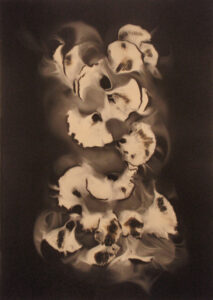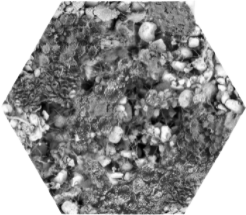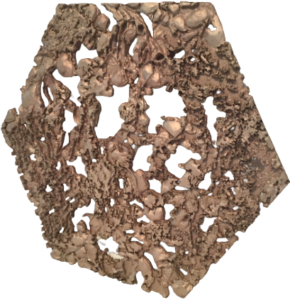This past Wednesday, I had the honor of talking with Professor Jim Toia, acclaimed artist and the Director of Community-Based Teaching at Lafayette College. We discussed his great appreciation for nature, and his effort to spread awareness for its unseen brilliance through artistic expression. Prof. Toia identifies himself as a nature and environmental enthusiast. Enamored by the wonders hidden in our environment, he was moved to creatively “harness its energy without disturbing it”. He often does this by allowing natural pigments of plants, animals, seeds, and fungi to be absorbed by various materials. One of his most common and well-known artworks

Image 1. Spore Drawings, Jim Toia
is his Spore Drawings. To develop these “drawings” or prints, he harvests mushrooms and spreads them out on paper. He then allows time for the tiny spores to eject out of the mushroom gills and onto the paper [2]. These drawings provide a different perspective into the invaluable natural life that surrounds us.
One of his more recent projects focuses on protecting one of the world’s most important and lesser-known ecosystems, desert crust. Prof. Toia explained that desert crust, which he identifies as cryptobiotic soil, is crucial to the health of the entire desert biome. This top layer of soil is made up of microscopic and some macroscopic organisms. When it rains, these organisms help to distribute the moisture by reproducing and creating long tunnels under the soil. When the soil dries out, this thin desert skin binds the soil particles together preventing wind and water erosion. This soil also helps to stabilize plants and store immense amounts of carbon and nutrients. With healthy soil, desert plants like the California Junipers can live up to 1000 years and grow roots as deep as 150 feet [3]! Another awesome feature of the desert soil ecosystem is that these plants take partnership with one of Prof. Toia’s primary art subjects, fungi. The fungal partners help to increase the health and safety of the desert plants by producing immune-boosting compounds and bitter-tasting chemicals. Perhaps, the most interesting aspect of the fungi-plant relationship is the network they create. They can transmit information to each other through what is coined as ‘nature’s internet’ [3]. Often overlooked, the entire desert biome acts as the world’s third-largest carbon sink [3]. The desert crust is the organism-rich seal that prevents erosion and windstorms, supplies nutrients, improves water infiltration, sequesters carbon, and helps keep the air clean and healthy.
With earnestness, Prof. Toia pointed out that an increase in development, urbanization and tourism is damaging this vital and delicate ecosystem. The desert crust takes hundreds of years to develop and can take up to 300 years to return to its healthy state after even minor disturbance. To protect the crust and spread awareness of its importance, Prof. Toia created “The Desert Crust Preservation Project” focused in Joshua Tree National Park. With this project, he designed and produced hexagonal panels bearing a print of a microscopic image of the desert crust and larger bronze and iron prototypes of the desert crust organisms. The hexagonal panels can be clipped together to form a protective layer on top of the desert soil. The desert crust panels and the prototypes are meant to be used at visitor centers, land trust sites, and educational institutions. The designs are both flexible and dynamic to maximize educational opportunities. See Images 2 and 3 below.
After learning about the “The Desert Crust Preservation Project”, I asked Prof. Toia what it will require to find a balance between

Image 2. Composite image of cryptobiotic soil designed as hexagonal panel. 21” from point to point.
human desires (ex. riding dirt bikes in the desert) and protecting, respecting, and appreciating the environment. He prefaced his response with a warning that he does not have the most positive outlook on the environment. I encouraged him to continue as I am aware of the many negative environmental realities of our future. Prof. Toia talked about our relationship with the environment and how detrimental it is that we often view ourselves as separate from nature. This separation takes away the responsibility of our actions on the environment. He noted that all species are looking for comfort and safety, but humans’ intellectual ability allows us to

Image 3. Bronze and Steel Hexagonal Prototypes
consume wastefully and destructively. Nature is incredibly resilient, but we have surpassed its bandwidth and are now suffering the consequences. Transitioning to the pandemic, Prof. Toia pointed out that he has seen a shift in younger generations’ attitudes toward the environment. Like natural disasters, the pandemic heightened people’s awareness. He identified that since the outbreak of COVID-19 he has noticed that younger individuals seem to care more about nature. When discussing next steps, Prof. Toia called on education as being foundational to creating a more resilient and sustainable environment. This belief is evident in his own work to educate communities about our immensely powerful and important diverse ecosystems. His art pieces emphasize the “faith, wonder, and insight” that is our natural world.
In many ways, the motivations behind Prof. Toia’s art and Janine Benyus’ biomimicry movement are the same. Both aim to highlight the immense value of the non-human nature that surrounds us. They, as individuals, are humbled by the 3.8 billion years of R&D nature has already done to create a sustainable environment and call on others to look to nature for inspiration. They both hope their work will aid in creating a more educated and symbiotic socio-environmental relationship. If you are interested in learning more about Prof. Toia’s work, see References 1 and 2.
References:
- Jim Toia’s art profile page: https://jimtoia.com/
- “Jim Toia: The Art of Uncertainty” (2015) WTTW video: https://video.wttw.com/video/state-arts-jim-toia-art-uncertainty/
- “The Desert Under Our Feet” (2019) article by Robin Kobaly accessed through Desert Report: https://desertreport.org/the-desert-under-our-feet-an-extraordinary-biological-web-that-serves-us-in-countless-ways/
- “Don’t bust the biological soil crust” article accessed through USDA U.S. Forest Service: https://www.fs.usda.gov/rmrs/dont-bust-biological-soil-crust-preserving-and-restoring-important-desert-resource